 |
|
| District
Museums are multipurpose Museums like the Central Museum at Chennai. District
Museums are established to preserve the cultural, artistic, natural and scientific
objects for the benefit of the public. Twenty District Museums are functioning under the
Department of Museums. The District Museums in addition to the preservation of the
cultural and natural heritage, entertains the visiting public providing enjoyment and
extend educational activities. Popular Lectures, Training Courses, Seminars, Competitions,
Exhibitions, Research Guidance, Outreach Programmes, Organised Tours etc., are some of the
educational activities of the District Museums.
Admission fee to the entire district Museums. Holidays – Fridays,
Second Saturdays and National Holidays. Working Hours: 9.30 a.m. to 5.00 p.m.
| Entrace Fee |
: |
Rs. 5/- for Adults
(Indian Nationals) |
|
|
Rs. 3/- for Children
below 12 years (Indian Nationals) |
|
|
Free for bonafide
students and teachers in groups with prior permission (Indian Nationals) |
|
|
Rs. 100/- or US $ 2
for Adults (Non-Indian Nationals) |
|
|
 |
|
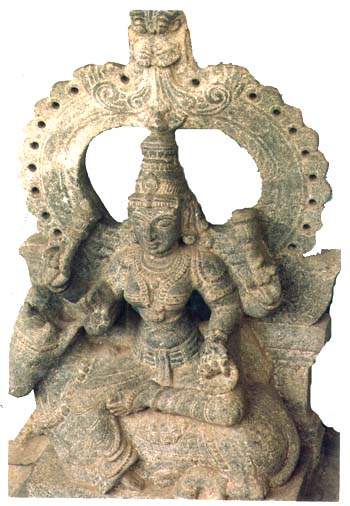
Stone Sculpture
Mother Goddess Seated on a Cattle
10th century AD.
|
GOVERNMENT MUSEUM, COIMBATORE
Address:
Curator,
Government Museum,
Kaleeswarar Nagar, Kattur,
Coimbatore 641 009.
The Museum was established in
1990. The collection include objects of Archaeology, Anthropology, Numismatics, Art,
Pre-history, Geology, Botany and Zoology. Of these the following exhibits merit special
mention due to their rarity and uniqueness:
Mesolithic stone tools,
calcimined bone remains of both animals, human beings acquired through scientific field
exploration from Vannathankarai site near Thakkalur - Kamanayakkanpalayam
via Avinashi.
Woodcarvings (18th Century
AD.), acquired from the Avinashilingeshwarar temple cars as gift from
the temple authorities concerned.
Bronze icons of Navaneetha Krishna (13th Century AD.); Hanuman
with Vishnu features (18th Century AD.) and Chandrasekhara with folk
elements (19th Contrary AD.) acquired through theTreasure-trove Act of 1878.
Stone sculptures of a mother goddess seated on a cattle (18th Century
AD.), a hero fighting with a panther / tiger by means of a muzzle loaded gun (16th
Century AD.) and Daksha (wih ram head) worshipping Vishwarupa Veerabhadra (13th
Century AD.), acquired as a treasure-trove find, scientific exploration and gifting
respectively.
Inscribed stone slabs
containing the details of commercial guild of Veerarajendra Chola period, acquired
through scientific field exploration find place in this Museum.
Tribal artifacts of Irula, Kadar,
Malagar and Muduvar acquired through both scientifc field exploration and
gifting.
|
| GOVERNMENT MUSEUM,CUDDALORE
Address:
Curator,
Government Museum,
19, Hospital Road,
Cuddalore – 607 001.
The Government Museum, Cuddalore was
established in the year 1989. A Sculpture Garden in the Museum welcomes the visitors. In
this sculputure garden Sivalinga, Nandhi, Vishnu, monkey scuptures, Narashima,
Surya and Chandikeswara are displayed. The development of Tamil script,
dinosaur model and a model of Kali sculpture made of Fibre glass are kept in the
entrance of the building.
The stone sculptures like Subramanya,
Surya, Navanitha Krishna, Dakshinamurthi, Bhairava,
Virabhadra, and Saptamatrika sculptures are best examples to the
sculptural wealth of our ancestors. Bronze images of Ganesa, Vishnu, Nataraja,
Somaskanda, Krishna are displayed in the Bronze Gallery.
In the first floor Kattunaickkan
Tribal materials, Stone Age tools, Musical Instruments, Agricultural implements of Kalvarayan
hill tribes are displayed.
Natural History specimens include
South Indian Timbers, Fibres, Swan, Bear, Lizard and Snakes. Wood fossils and Ammonite
fossils are also on display.
This Museum collection represents
history, culture, flora and fauna of the district. Imparting knowledge to researchers,
students and public through popular lectures, exhibitions and training programmes form
part of educational activities.
|

Devi
Bronze
14th Century AD.
|

Dakshinamurthi
Erode District.
12th Century AD.
|
GOVERNMENT MUSEUM, ERODE
Address:
Curator,
Government Museum,
Municipal Office Campus,
Erode – 638 001.
The Museum was
opened to the public in 1987. The important exhibits are inscription of Kongu Chola,
hero stones from Bargur, Tanjore paintings, manuscripts, coins, geological objects,
Kodumanal antiques and other pre-history items. It has both botanical and
zoological specimens also. The Museum is known for its collection of palm-leaf manuscripts
and coins. |
GOVERNMENT MUSEUM, KANCHIPURAM
Address:
Curator,
Government Museum,
44/117,M.M. Avenue,
Kanchipuram–631 501
Kanchipuram, one of the seven holy cities of India, is
situated 75 km south-west of Chennai. It was the seat of both the Pallavas and the Cholas,
and is the best place for studying South Indian antiquarian remains. Saivism, Vaishnavism,
Buddhism and Jainism have their influence here and justify behind their
traces as distinct temples and monuments. The Sangam poet Kadiyalur
Vuruthirnkannanar, In the Perumpanatrupadai has described Kanchipuram as
a lotus bud surrounded by a circular fort. Several epigraphical records, inscriptions are
available, which throw light on the history of ancient kings such as Pallavas, Cholas,
Pandavas, Telugu Cholas, Kakatiyas, Vijayanagar kings, Muslim and English rulers. As
one more jewel to the crown of the city, the Kanchipuram Government Museum was
dedicated to the public in 1999.
The Museum display archaeological,
anthropological, geological, botanical, zoological and numismatic materials of importance.
The Introductory Gallery display the photos of important monuments and places of interest
found in the district along with a detailed map. Any visitor who visits the Museum can get
a comprehensive picture of the historical and cultural aspects of Kanchipuram and also
understand about the natural resources and life of the people. |

A view of the Gallery |

Vishnu
Stone Sculpture
17th Century AD

Recently a new gallery “Travancore Gallery” has been added
in the Government Museum, Kanyakumari District. His Highness Marthanda Varma Sri Uthiradam
Thirunal (the Maharaja of Travancore) inaugurated the gallery on 17th September
2003 in the presence of Thiru Rajesh Lakhani, I.A.S. District Collector, Kanyakumari
District. Dr. R.Kannan, Ph.D. I.A.S.,Commissioner of Agriculture and Museums presided over
the function. |
GOVERNMENT MUSEUM, KANNIYAKUMARI
Address:
Curator,
Government Museum,
Gandhi Mandabam Road,
Kanniyakumari- 629 702
The Museum was opened
to the public in 1991.
Bronzes belonging to 15th Century AD
such as Tirumangai Alwar, Manickavasakar, Rama, Nataraja and stone sculptures of
7th Century AD (Vishnu), East India Company coins, musical instruments,
arms, tribal materials are the exhibits of special mention.
A good collection of marine
exhibits and dioramic representation of Natural History specimens attract the visitors.

|
| GOVERNMENT MUSEUM, KARUR
Address:
Curator,
Government Museum,
Daily Market Complex,
Karur Bus Stand,
Karur – 639 001.
The Museum was
opened to the public in 2000. The specimens include bronze items, metal-ware objects,
musical instruments, coins, rocks and minerals, fossils, botanical specimens, molluscan
shells, and other marine specimens.
The educational activities of this
Museum include Guide service, popular lectures etc. |

Rock with Jain Sculpture
Aiwarmalai
|
 Megalithic
Burial Urn |
GOVERNMENT MUSEUM,
KRISHNAGIRI
Address:
Curator
Government Museum,
Near Apsara Theatre, Gandhi Road,
Krishnagiri – 635 001.
The district Museum was opened to the public in
1993. Dharmapuri district is famous for pre-historic burial sites, archaelogical monuments
and for Tribal culture. Sculptures, bronzes, neolithic stone tools, burial potteries,
tribal (Kurumba and Lambadi) materials and hero stones are special exhibits.
The Museum has good diorama showcases with objects of botany, geology and zoology.
|
GOVERNMENT MUSEUM,
MADURAI.
Address:
Curator,
Government Museum,
Gandhi Museum Campus,
Madurai – 625 020,
Phone: +91-0452-650298.
Madurai Museum
was established in the year 1980. Interesting collections such as bronzes, sculptures,
musical Instruments, paintings,Geological,Botanical and Zoological specimens are on
display.
Training programmes on Tanjore
painting, Batik art, taxidermy, screen printing are conducted. In addition to this,
special summer training camps on Tamil music, bharathanatyam, karate,
yoga, varmakkalai, photography, glass painting, fabric painting and doll making are
also conducted. |

Entrance view of the museum building
|
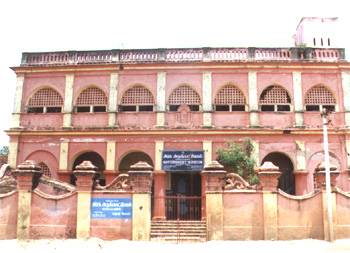
Front View of the museum Building
|
GOVERNMENT MUSEUM, NAGAPATTINAM
Address:
Curator,
Government Museum,
First Line Beach,
Nagapattinam – 611 001.
The Museum was opened
to the public in 1999.
The galleries present in this Museum
are:
District Introduction Gallery,
Bronzes and metal-ware Gallery,
Paintings Gallery (contemporary paintings),
Natural History Gallery,
Anthropological Gallery (Musical Instruments,
Palaeolithic tools),
Working models on Natural History.
The educational activities include
Guide service, Competitions, popular lectures, seminars etc.
|
| GOVERNMENT MUSEUM, PALANI
Address:
Curator,
Government Museum.
Foot of the Hill,
Palani – 624 601.
The district Museum at
Palani was established in 1997. The Museum was started with rudimentary collection from
the reserve stock of exhibits from the Chennai Museum. Over the years the Museum
collection was enriched with acquisition of more exhibits through the Treasure - trove Act
of 1878, surface collection, purchase, gift etc.
Important
Exhibits
The important exhibits include the bronzes from Palani
taluk, such as Nataraja from Tamaraikulam, dated to the 11th Century AD., Venugopal
from Thanjavur, Subramania and Valli (17th Century AD) from Palani and the
Dancing Krishna from Tanjore.Folk bronzes are also on display
revealing the crude folk technique of casting bronzes.
A hero - stone with inscription of the 16th Century AD.,
is displayed in front of the Museum. Sculptures belonging to the period from about 15th
Century AD to 19th Century AD are displayed. Wood carvings (About 11th Century AD) from
temple cars are also exhibited.
Out of the coins collection, one of the most interesting
collections is that of Palani coins (17th Century AD) received as gift. This coin has one
side the figure Peacock and other side inscribed the name 'Palani' in Tamil.
A stuffed specimen of sea snake, which was acquired
recently from Tuticorin, is displayed. It is one of the good specimen exhibited in
this Museum. Another interesting exhibit is stuffed specimen of an ant-eater.
Besides, modern paintings of different artists,
Indian and foreign stamps, small metal figures, burial-urns, the materials used by the
hill tribes etc., are displayed.
Educational Activities
The educational activities include special
exhibitions, monthly popular lectures, seminars, competitions, training programmes etc. |

Nataraja
11th Century AD
|
| 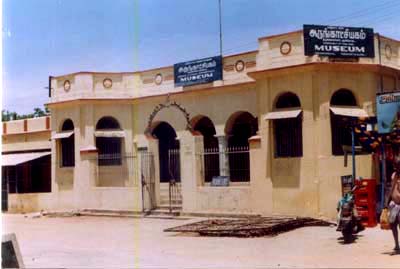
Government Museum
Pudukkottai

Pudukkottai Textiles
19th Century AD.

Wood Carving
18th Century AD.
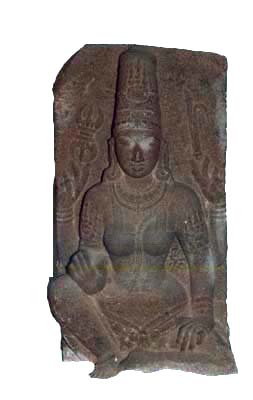
Indirani
10th Century AD.
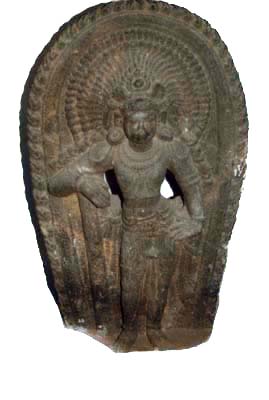
Surya
10th - Century AD. |
GOVERNMENT MUSEUM, PUDUKKOTTAI
Address:
Curator,
Government Museum,
Thirugokarnam,
Pudukkottai – 622 002,
Phone : +91-04322-22247.
Government
Museum, Pudukkottai was opened to the public in the year 1910 by the then Thondaiman
ruler of the erstwhile Pudukkottai Princely State. It is the second largest Museum in
Tamilnadu. It houses objects of cultural and natural resources of this area. A variety of
invertebrates, about 200 species of birds, eggs of birds, fishes, snakes, mammals, art
objects, wood carvings, textiles, paintings, pictures, musical instruments, pre-historic
tools and materials, weapons of different description, ornaments, historical records,
copper plates, enchanting sculptures, beautiful bronzes, coins etc., are on display. A
visit to the Museum can give a complete historical glimpse of the area. |
| GOVERNMENT MUSEUM, RAMANATHAPURAM
Address:
Curator,
Government Museum,
Head Post Office Road,
Ramanathapuram - 623 501.
The
Museum was established in March 2000. Bronzes, wood carvings, metal-ware objects, coins,
rocks and minerals, pre-historic tools, paintings, tribal materials, herbarium sheets,
timber varieties and other natural history materials are on display. |

Devi -Stone Sculpture |
| 
A view of the museum building |
GOVERNMENT MUSEUM,
SALEM
Address:
Curator,
Government Museum,
Navalar Road,
Salem – 836 001.
The Salem Government Museum was
formed by the District Collector with the support of the Local Artist Group called
Contemporary Writers and Painters Association. The Museum was opened to the public in the
year 1976.
The following Galleries are Present
Pre-history, Sculpture, Ethnology,
District Information, Geology, Botany, Zoology, Arms, Philately, Numismatic and Paintings.
|
| GOVERNMENT
MUSEUM, SIVAGANGA
Address:
Curator,
Government Museum,
Weekly Market Road,
Sivaganga – 630 561.
The Museum was opened to the public
in 1998. Exhibts such as sculptures, bronzes, wood-carvings, natural history specimens
adorn the Museum.
Musical stone received from Forest
Department, part of fossilised tree received as gift from Thiru Ravichandran of Thiruvakkarai
and portraits (sculptures) of Sivaganga King Podaguru who ruled from Sivaganga
from 1848 to 1863 are some of the rare specimens on display.
A good collection of burial-urns, arms and tribal
materials are also on display. |
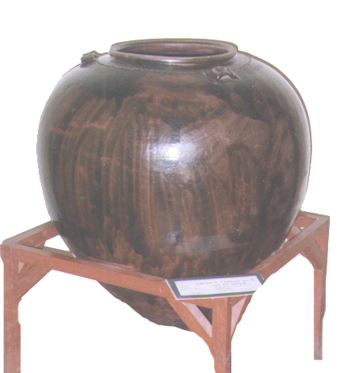
Oil Storage Urn |
| 
Bronze Icons
15th-19th Century AD. |
GOVERNMENT MUSEUM, TIRUNELVELI
Address:
Curator,
Government Museum,
St. Mark’s Road,
Near the office of the Superintendent of Police,
Tirunelveli - 627 002.
The
Museum is famous for burial urns, terracotta objects, marine collections, bronze icons,
arms and tribal materials. The Museum with its exquisite bronzes of Somaskanda, Ganesa,
Ayyanar, Devi and Siva datable to 15th Century AD., portraying the delicate
rhythmic workmanship, which prevailed during the period.
The art of wood-carving confirms the
fact that ancient Tamils were expert in preparing works of art in wood apart from
stone and metal.
A set of metal cast coins from 5th
Century BC. rightdown through the ages of Kushanas, Guptas, Chalukyas, Mughals, Cholas,
Pandyas, Vijayanagar kings and the East India Company also adorn the gallery.
The ancient weapons on display depict
the type of warfare and social culture of the ancient Tamils. Kani tribals
and Adichanallur megalithic excavations are depicted dioramatically, while Kattunaicken
and Palliyan tribal life and activities are picturised through their material
culture.
Colourfully set up dioramas of a bird
sanctury, coral reef, aquatic environment and systematic arrangement of invertebrate
collections are other noteworthy attracting exhibits in this Museum.
Kalamkari paintings, batik
paintings and Raja Ravi Varma paintings are also on display.
|
| GOVERNMENT MUSEUM, TIRUVARUR
Address:
Curator,
Government Museum,
Arul Migu Thiyagaraja Swami Thirukkovil,
Thiruvarur- 610 002.
The Museum was
opened to the public in 1998. The Museum is located in an ancient Mandapa, which is
300 years old.
Sculptures from 10th to 17th Century AD., bronzes from the period
between 12th and 14th Century AD., wood-carvings (150 years old), metalware decorative
items of 14th Century AD Period, musical instruments,arms (Muzzle loading guns) burial
potteries, palaeolithic , neothochic tools, tribal materials and natural history specimens
are some of the objects worth mentioning.
|
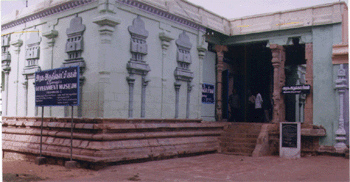
A View of the museum Entrance |
| 
Statue of Buddha
10th Century AD |
GOVERNMENT MUSEUM, TIRUCHIRAPPALLI
Address:
Curator,
Government Museum,
Rani Mangammal Hall,
Tiruchirappalli – 620 002.
The Government
Museum, Tiruchirappalli was inaugurated in 1983. The Museum is situated in a historical
building (a Monument of Nayak rule) called Rani Mangammal Building.
Objects such as stone sculptures,
bronzes, wood carvings, stone inscriptions, palm leaf manuscripts, coins, philatelic
materials, paintings are on display.
Stone tools, pots and potsherds of
Megalithic Period, musical instruments and tribal objects form the interesting part of the
collection.
In the natural history side, a number
of fossils, minerals, an array of animal bones and herbaria of medicinal plants are also
on display.
Film shows, competitions of different
kinds, workshops in museology and training on epigraphy are a few of the educational
activities conducted by the Museum.
|
| GOVERNMENT MUSEUM, UDAGAMANDALAM.
Address:
Curator,
Government Museum,
Bali House,
70, Mysore Road,
Udagamandalam - 643 001.
The Museum
is famous for its natural history collections, coins, sculptures, bronzes and
anthropological exhibits. A good collection of tribal materials of The Nilgiris are also
on display. |

Entrance view of the museum building |
| 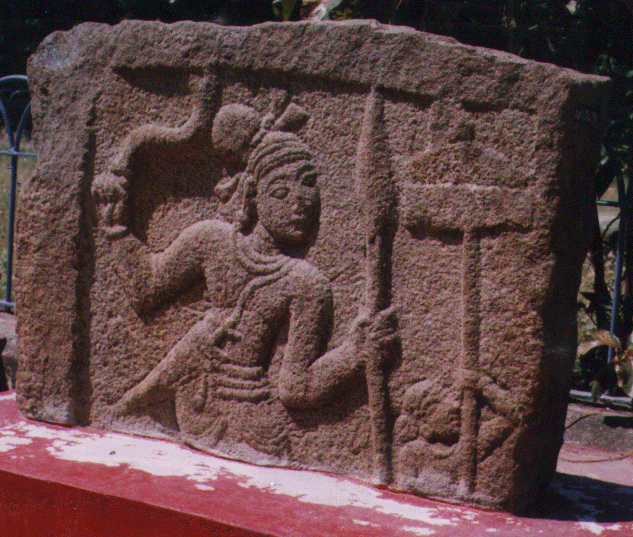
Hero Stone
9th Century AD |
GOVERNMENT
MUSEUM, VELLORE
Address:
Curator,
Government museum,
Fort,
Vellore – 632 004.
This Museum was
opened to the public in 1985. It consists of objects of art, archaeology, pre-history,
weapons, sculptures, bronzes, wood carvings, handicrafts, numismatics, philately, botany,
geology and zoology.
Special exhibits include Bronze
double antenna sword from Vellore Taluk, dating back to 400 BC., Stone sculptures from
Late Pallava to Vijayanagar periods, Ivory chess board and coins used by the last Kandian
King of Sri Lanka, Vikrama Raja Singha.
The educational activities of this
Museum include Art camp for school students, Study of inscriptions and iconography for
college students etc. |
| GOVERNMENT MUSEUM, VIRUDHUNAGAR
Address:
Curator,
Government Museum,
D.D. Road,
Mani Nagaram,
Virudhunagar- 626 001.
The Museum was open to
the public in the year 2001. The specimens include bronze items, acquired as
treasure-trove objects from Virudhunagar district, photos of coins acquired as
treasure-trove objects from Virudhunagar district, Indian coinage ( metal-cast set),
fossil specimens, pre-historic tools, leather puppets, herbarium sheets, timber varieties,
terracotta objects, musical instruments, satellite models, molluscan shells, insects etc.
are on display. |

Srinivasa with Consorts
15th Century AD |
|
|
|